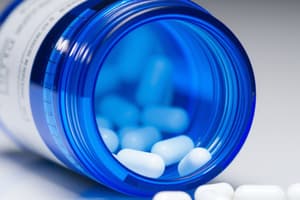Podcast
Questions and Answers
What is the brand name of Oxybutynin?
What is the brand name of Oxybutynin?
- Ditropan XL (correct)
- Ditropan
- Urinary Tract Antispasmodics
- Oxybutynin
What is the generic name for Ditropan XL?
What is the generic name for Ditropan XL?
Oxybutynin
What is the therapeutic classification of Oxybutynin?
What is the therapeutic classification of Oxybutynin?
Urinary Tract Antispasmodics
What is the pharmacologic classification of Oxybutynin?
What is the pharmacologic classification of Oxybutynin?
Oxybutynin inhibits the action of acetylcholine at postganglionic receptors, and has a direct spasmolytic action on ________ muscle.
Oxybutynin inhibits the action of acetylcholine at postganglionic receptors, and has a direct spasmolytic action on ________ muscle.
What are the therapeutic effects of Oxybutynin?
What are the therapeutic effects of Oxybutynin?
What precautions should be taken when using Oxybutynin?
What precautions should be taken when using Oxybutynin?
List some adverse reactions or side effects of Oxybutynin.
List some adverse reactions or side effects of Oxybutynin.
What implementations should be taken when administering Oxybutynin?
What implementations should be taken when administering Oxybutynin?
What is the usual route and dosage of Oxybutynin?
What is the usual route and dosage of Oxybutynin?
Flashcards are hidden until you start studying
Study Notes
Brand Name
- Oxybutynin is marketed under the brand name Ditropan XL.
Generic Name
- The generic name for Ditropan XL is Oxybutynin.
Therapeutic Classification
- Classified as a urinary tract antispasmodic.
Pharmacologic Classification
- Falls under anticholinergics, which inhibit certain neurotransmitter functions.
Mechanism of Action
- Inhibits acetylcholine at postganglionic receptors, leading to relaxation of smooth muscle in the urinary tract without affecting vascular smooth muscle.
Therapeutic Effects
- Increases bladder capacity and delays the sensation of needing to void.
- Reduces urge incontinence, urinary urgency, frequency, and the number of urinary accidents in patients with overactive bladder.
Contraindications/Interactions
- Use with caution in patients with alcohol use disorder, elderly patients, gastroesophageal reflux disease (GERD), hypertension, and cardiac disease.
- Notable interactions include potential anticholinergic effects when combined with certain depression medications and CNS depressants.
Adverse Reactions/Side Effects
- Serious side effects may include hallucinations, seizures, tachycardia, arrhythmias, hypertension, dizziness, urinary tract infections (UTIs), and blurred vision.
- Other common side effects can include dry eyes, insomnia, dysuria, cough, abdominal pain, and confusion.
Implementation Strategies
- Monitor patient voiding patterns and input/output (I&O) ratios.
- Assess for bladder distention and overall abdomen condition.
- Check for signs of sedation and weakness.
- Administer medication on an empty stomach, ensuring the tablet is swallowed whole.
Route/Dosage
- Recommended dosage is one 5 mg tablet taken orally twice daily.
Studying That Suits You
Use AI to generate personalized quizzes and flashcards to suit your learning preferences.




